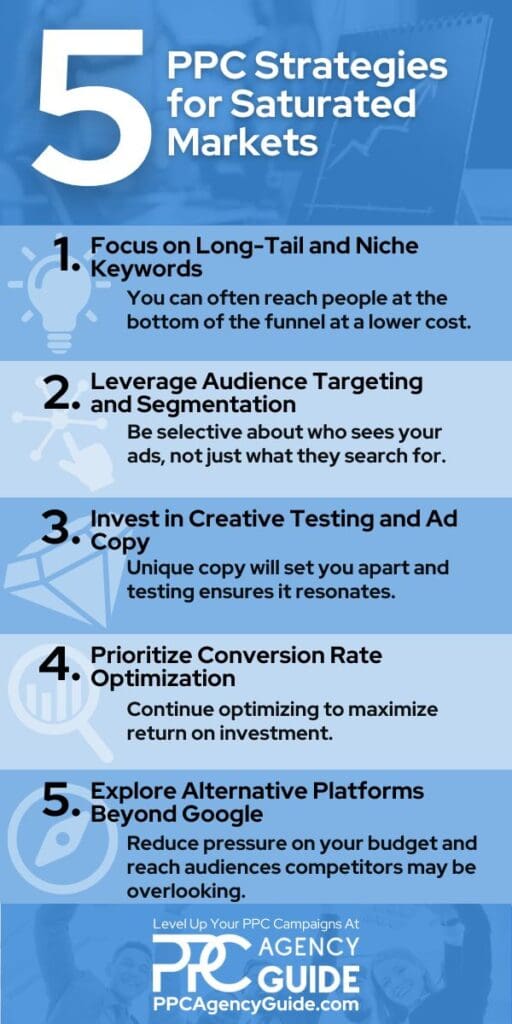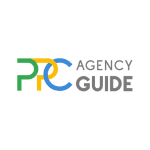
Seeing dwindling results or sky-high cost-per-click (CPC) rates? You might be in a saturated pay-per-click market. Give us a few minutes, and we’ll walk you through how to check, what it means for your approach if you are, and proven PPC strategies for saturated markets you can start leveraging right away.
How to Tell if You’re in a Saturated Market
Market saturation happens when you are competing against many businesses offering the same or very similar products or services. In PPC, this shows up as higher competition for the same keywords, more ads fighting for the same audience, and ultimately, rising costs. But how do you actually know if you are operating in a saturated market?
General Signs of Market Saturation
- High Cost Per Click (CPC): If you notice that the cost to appear on the first page of search results is consistently climbing, it is often a sign that multiple competitors are bidding aggressively on the same terms. Google Ads’ Keyword Planner is a good tool to check CPC ranges in your industry.
- Low Impression Share: Impression share measures how often your ad is shown compared to how often it could be. If your impression share is low despite having competitive bids and budgets, it indicates a crowded space where many others are targeting the same audience.
- Limited Keyword Availability: In a saturated market, the most obvious keywords are already heavily bid on. You may find yourself struggling to identify fresh, high-intent keywords that competitors are not already targeting.
- Ad Fatigue Among Audiences: When audiences see very similar ads over and over again, performance drops. If your click-through rate is declining even though your targeting and creative are solid, saturation may be to blame.
- Difficulty Differentiating Offers: If your competitors’ ads and landing pages look nearly identical to yours in terms of messaging, price points, or features, it is a clear sign that the market has reached a point of saturation.
Data You Can Use to Confirm You’re Leveraging PPC in Crowded Markets
You can use specific tools and metrics to verify whether you are in a saturated market.
- Auction Insights Report: The Auction Insights Report in Google Ads shows which competitors are bidding on the same keywords and how often they appear above you.
- Industry Benchmarks: Reports from WordStream or Statista can show you average CPC and conversion rates in your industry, giving you a comparison point.
- Search Volume Trends: Check your search terms in a tool like Google Trends. If interest in your keywords is steady but costs and competition are climbing, it suggests saturation.

How Market Saturation Affects PPC Campaigns
When your industry is crowded, PPC campaigns behave differently. Understanding what makes your situation unique makes it easier to develop realistic long-term goals for competitive PPC and create a strategy that works.
Challenges of PPC in Crowded Industries
If you’ve experienced any of the signs mentioned earlier, you’re likely coping with numerous market saturation challenges. Because they may not all be obvious, we’ll cover a few below.
- Shrinking Profit Margins: As cost per click rises, your customer acquisition cost goes up, leaving less room for profit.
- Unstable Performance: Results fluctuate more because auctions are highly competitive, and small bid changes can move you dramatically.
- Creative Burnout: Ads need to be refreshed more often since prospects are exposed to many similar messages.
- Slower Return on Investment (ROI) Timeline: It takes longer to recoup your investment as buyers compare more options before converting.
Shifts in Campaign Dynamics
Beyond the challenges, saturation changes how you need to approach advertising.
- Specific Metrics Become More Vital: You must prioritize customer lifetime value and return on ad spend, not just ad clicks or conversions.
- Optimization is Essential: Ongoing optimization of campaigns is always recommended. Small adjustments help boost the effectiveness of your ads and improve ROI. However, it becomes even more important in saturated markets because each lead is harder to win and convert.
- Brand Equity Plays a Bigger Role: In crowded spaces, customers gravitate to names they recognize, meaning brand-building works hand in hand with PPC.
Top 5 Competitive PPC Strategies for Saturated Markets
At this point, you’ve confirmed you’re in a saturated market and have a better understanding of how that influences your results and the types of shifts you’ll need to make. Here’s what to do next.
1. Focus on Long-Tail and Niche Keywords
Many businesses focus on obvious keywords like “insurance,” “lawyer,” or “digital marketing agency.” However, these are usually the most expensive and competitive. If you try to compete head-to-head on those terms, your costs rise quickly while your returns shrink.
Long-tail keywords are longer, more specific phrases that capture a clearer intent. For instance, when you’re targeting high-intent keywords in PPC, you wouldn’t just advertise for “personal injury lawyer.” You’d use a long-tail keyword like “personal injury lawyer free consultation Toronto.” And, instead of “running shoes,” you might use “lightweight women’s trail running shoes.”
These types of keywords actually make up around 70 percent of search traffic, according to Search Engine Journal. While they may draw fewer clicks individually, they typically come from people who know what they want and are closer to making a decision. You may also see less competition for them, which can help you stretch your budget further.
How to Use Long-Tail and Niche Keywords in Your Campaigns
- Look for Intent: Build your keyword lists around how people search when they are ready to buy or book, not when they are just researching.
- Layer on Geography: Adding cities, neighborhoods, or “near me” modifiers narrows the field and attracts local buyers.
- Mine Your Data: Your own search term reports are often the best source of hidden long-tail opportunities.
2. Leverage Audience Targeting and Segmentation
When keywords alone cannot give you an edge, audience targeting becomes your competitive advantage. Saturated markets are filled with businesses bidding on the same terms, but you can separate your campaigns by choosing who sees your ads, not just what they search for.
For instance, picture two people searching for a Hermes bag. One might be a serious buyer who is deciding which design they like best and getting ready to purchase, while the other might just be trying to price out the bag they saw a celeb carrying. Both might click your ad, but only one has the potential to convert.
By layering audience targeting on top of keywords, you can prioritize your budget for the prospects most likely to convert. Google’s in-market audiences, for example, let you target people actively researching products or services like yours.
Practical Ways to Segment
- In-Market Audiences: Reach people showing buying signals, such as researching insurance, comparing software, or shopping for a car.
- Remarketing Lists: Use remarketing to serve ads to users who visited your site but did not convert, reminding them to take the next step.
- Custom Segments: Build audiences around competitor-related searches, visits to websites in similar categories, or usage of related apps. While you cannot target a competitor’s site visitors directly, you can reach people who have recently searched for competitor brand names or browsed comparable sites.
- Geography and Demographics: Combine age, income, or location with keyword targeting to refine who sees your ads.
3. Invest in Creative Testing and Ad Copy Differentiation for PPC
Ad space is limited. On a Google search results page, you may only get a few lines of copy and some extensions to convince a prospect to choose you over half a dozen competitors. If your ads blend in with everyone else’s, even a strong budget will not guarantee clicks. Crafting unique ad copy for crowded markets sets you apart, though you must also ensure your messages resonate. Small differences can have a major impact here.
Tips for Creative Testing and Using Differentiation in Saturated PPC Campaigns
- Watch Others: Start by analyzing competitor PPC ads to see what they’re saying and how you can make your wording or offer stand out.
- Highlight Unique Proof: For instance, instead of saying you offer “fast delivery,” show the number of hours or days you can guarantee.
- Leverage Social Proof: Use review counts, testimonials, or third-party ratings to build trust.
- Test Bold Hooks: Run A/B tests on headlines with different tones, such as professional, urgent, or even conversational, to see what resonates.
- Refresh Frequently: Rotate creative more often in crowded spaces, where audiences tire quickly of repeated messages.
4. Prioritize Conversion Rate Optimization
In a saturated market, every click costs more. That means your ability to turn those clicks into customers has a direct impact on whether your campaigns stay profitable. Conversion rate optimization (CRO) is the lever that helps you get more from the traffic you already paid for.
Tips for Optimizing PPC for Market Saturation Challenges
- Streamline Landing Pages: Remove distractions and keep the call-to-action clear. A cluttered design often causes drop-offs.
- Test Form Length: Ask only for the essentials. Long forms depress conversion rates, especially on mobile.
- Align Message to Ad: Make sure the headline and offer on your landing page directly reflect the ad copy that drove the click.
- Use Social Proof: Adding reviews, testimonials, or security badges can increase trust in crowded industries where prospects hesitate.
5. Explore Alternative Platforms Beyond Google
Most businesses in saturated markets pour the bulk of their budget into Google Ads. That makes sense because it is the largest platform, but it also means Google is where competition and costs are often highest. It’s essential to consider other advertising platforms. When you expand beyond Google Ads, you can reduce pressure on your budget while gaining access to audiences your competitors may be overlooking.

Additional Platforms for Effective PPC for Crowded Industries
- Microsoft Ads: If you’re comparing Google Ads vs. Microsoft Advertising, Google wins for volume. However, Microsoft Advertising tends to be much more affordable and functions like Google on the back end, so it’s a very easy transition for most.
- LinkedIn Ads: If you run a B2B company and want to target decision-makers by job title, company size, or industry, LinkedIn is likely a great addition to your strategy.
- Meta Ads: Both Facebook and Instagram tend to perform well for consumer products and services, particularly where visual storytelling drives conversions.
Work with Someone Who is Experienced in Managing PPC in Saturated Markets
Understanding the fundamentals of PPC strategies for competitive niches is one thing. Having the time, resources, and nuanced skill set to implement them is another. If you need high-performing ads and operate in a saturated market, a pro can shorten your time to results and boost ROI. To be matched with an experienced agency, request a free consultation.
FAQs on PPC Strategies for Saturated Markets
How can I ensure I get ROI in competitive PPC?
Optimizing ROI in PPC campaigns comes down to more than bidding strategy. Strong landing pages, precise targeting, and regular creative testing all improve conversion rates. In competitive industries, even small improvements in click-through and conversion can offset higher costs, ensuring every dollar invested delivers measurable results over time.
How do I go about building brand awareness with PPC in saturated industries?
In saturated industries, brand awareness often requires running campaigns beyond search. Display ads, YouTube, and social platforms let you reach new audiences at scale. Pairing broad visibility campaigns with remarketing helps you stay top of mind, so prospects recognize your business when they are ready to make a purchase.
What are some tricks for balancing ad spend in saturated markets?
Resource allocation for competitive PPC strategies often involves spreading investment across multiple platforms, not just Google. Running campaigns on Microsoft, LinkedIn, or Meta can reduce costs while opening new audience pools. Balancing spend also means protecting budget for remarketing, ensuring you maximize the value of every prospect you reach.
What are best practices for budgeting PPC for competitive spaces?
Competitive bidding strategies for PPC begin with understanding your profit margins and customer lifetime value. From there, resource allocation in PPC campaigns should emphasize the keywords, audiences, and platforms that produce the best return. Continual testing and reallocating funds based on performance ensures your budget is always working effectively.
How do you develop high-impact PPC campaigns for competitive niches?
High-impact PPC in competitive niches requires a mix of sharp differentiation and rigorous testing. Focus on ad copy that highlights unique proof points, align landing pages closely with ad promises, and refresh creative frequently. When every competitor is bidding on the same terms, creative execution often becomes your strongest advantage.
Why does shifting focus to retention in competitive PPC matter?
In competitive PPC, acquiring new customers can be costly, so retention helps increase profitability. Remarketing campaigns, loyalty offers, and personalized upsell ads extend the value of each customer. By balancing acquisition with retention, you reduce reliance on expensive clicks while building a stronger long-term foundation for growth.
What does competitive targeting in saturated PPC markets look like?
Ad targeting strategies for PPC in crowded markets often combine precise keyword selection with layered audience filters. Instead of targeting broadly, you refine campaigns using in-market audiences, geographic restrictions, or competitor-related search behavior. This ensures your ads reach prospects with higher intent, improving return on spend in saturated industries.
What tools can be used for performance tracking for PPC campaigns?
Performance tracking for PPC campaigns often starts with Google Ads and Microsoft Ads dashboards, paired with Google Analytics for cross-channel insight. Tools like Semrush or Optmyzr can add deeper reporting, while heatmaps and A/B testing software highlight landing page performance. Together, these tools help you measure and refine campaign impact.
How do I get started refining PPC campaigns with performance metrics?
Refining PPC campaigns with performance metrics begins by choosing the right benchmarks, such as conversion rate, cost per acquisition, and return on ad spend are usually more valuable than clicks alone. From there, review reports regularly, run small tests, and shift budget toward the best-performing segments. Incremental improvements add up quickly in competitive spaces.


















